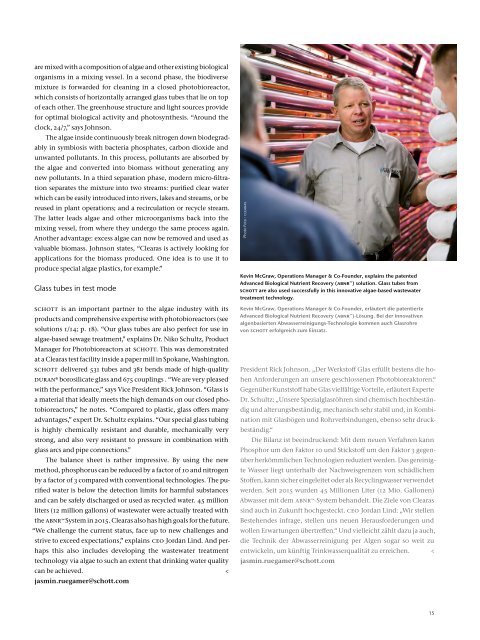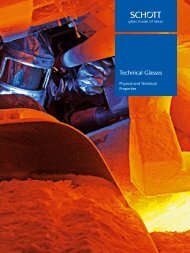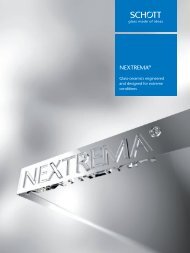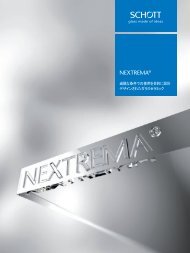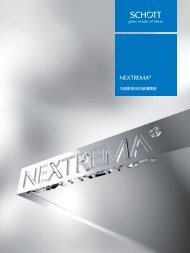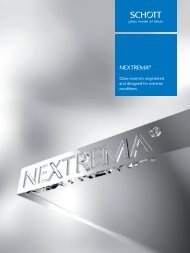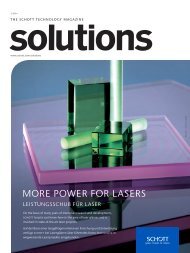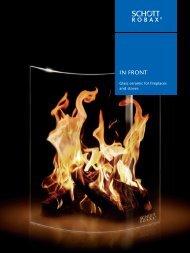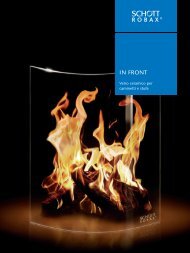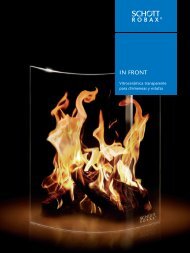Technology Magazine "SCHOTT solutions" Edition 1/2016
The SCHOTT solutions glass magazine features articles, reports and interviews on glass technological challenges from all over the world. The SCHOTT Technology Magazine. Beiträge, Reportagen und Interviews zu Lösungen von SCHOTT für technologische Herausforderungen weltweit.
The SCHOTT solutions glass magazine features articles, reports and interviews on glass technological challenges from all over the world.
The SCHOTT Technology Magazine. Beiträge, Reportagen und Interviews zu Lösungen von SCHOTT für technologische Herausforderungen weltweit.
You also want an ePaper? Increase the reach of your titles
YUMPU automatically turns print PDFs into web optimized ePapers that Google loves.
are mixed with a composition of algae and other existing biological<br />
organisms in a mixing vessel. In a second phase, the biodiverse<br />
mixture is forwarded for cleaning in a closed photobioreactor,<br />
which consists of horizontally arranged glass tubes that lie on top<br />
of each other. The greenhouse structure and light sources provide<br />
for optimal biological activity and photosynthesis. “Around the<br />
clock, 24/7,” says Johnson.<br />
The algae inside continuously break nitrogen down biodegradably<br />
in symbiosis with bacteria phosphates, carbon dioxide and<br />
unwanted pollutants. In this process, pollutants are absorbed by<br />
the algae and converted into biomass without generating any<br />
new pollutants. In a third separation phase, modern micro-filtration<br />
separates the mixture into two streams: purified clear water<br />
which can be easily introduced into rivers, lakes and streams, or be<br />
reused in plant operations; and a recirculation or recycle stream.<br />
The latter leads algae and other microorganisms back into the<br />
mixing vessel, from where they undergo the same process again.<br />
Another advantage: excess algae can now be removed and used as<br />
valuable biomass. Johnson states, “Clearas is actively looking for<br />
applications for the biomass produced. One idea is to use it to<br />
produce special algae plastics, for example.”<br />
Glass tubes in test mode<br />
schott is an important partner to the algae industry with its<br />
products and comprehensive expertise with photobioreactors (see<br />
solutions 1/14; p. 18). “Our glass tubes are also perfect for use in<br />
algae-based sewage treatment,” explains Dr. Niko Schultz, Product<br />
Manager for Photobioreactors at schott. This was demonstrated<br />
at a Clearas test facility inside a paper mill in Spokane, Washington.<br />
schott delivered 531 tubes and 381 bends made of high-quality<br />
duran® borosilicate glass and 675 couplings . “We are very pleased<br />
with the performance,” says Vice President Rick Johnson. “Glass is<br />
a material that ideally meets the high demands on our closed photobioreactors,”<br />
he notes. “Compared to plastic, glass offers many<br />
advantages,” expert Dr. Schultz explains. “Our special glass tubing<br />
is highly chemically resistant and durable, mechanically very<br />
strong, and also very resistant to pressure in combination with<br />
glass arcs and pipe connections.”<br />
The balance sheet is rather impressive. By using the new<br />
method, phosphorus can be reduced by a factor of 10 and nitrogen<br />
by a factor of 3 compared with conventional technologies. The purified<br />
water is below the detection limits for harmful substances<br />
and can be safely discharged or used as recycled water. 45 million<br />
liters (12 million gallons) of wastewater were actually treated with<br />
the abnr System in 2015. Clearas also has high goals for the future.<br />
“We challenge the current status, face up to new challenges and<br />
strive to exceed expectations,” explains ceo Jordan Lind. And perhaps<br />
this also includes developing the wastewater treatment<br />
technology via algae to such an extent that drinking water quality<br />
can be achieved. <<br />
jasmin.ruegamer@schott.com<br />
Photo Foto : clearas<br />
Kevin McGraw, Operations Manager & Co-Founder, explains the patented<br />
Advanced Biological Nutrient Recovery (abnr) solution. Glass tubes from<br />
schott are also used successfully in this innovative algae-based wastewater<br />
treatment technology.<br />
Kevin McGraw, Operations Manager & Co-Founder, erläutert die patentierte<br />
Advanced Biological Nutrient Recovery (abnr)-Lösung. Bei der innovativen<br />
algenbasierten Abwasserreinigungs-Technologie kommen auch Glasrohre<br />
von schott erfolgreich zum Einsatz.<br />
President Rick Johnson. „Der Werkstoff Glas erfüllt bestens die hohen<br />
Anforderungen an unsere geschlossenen Photobioreaktoren.“<br />
Gegenüber Kunststoff habe Glas vielfältige Vorteile, erläutert Experte<br />
Dr. Schultz: „Unsere Spezialglasröhren sind chemisch hochbeständig<br />
und alterungsbeständig, mechanisch sehr stabil und, in Kombination<br />
mit Glasbögen und Rohrverbindungen, ebenso sehr druckbeständig.“<br />
Die Bilanz ist beeindruckend: Mit dem neuen Verfahren kann<br />
Phosphor um den Faktor 10 und Stickstoff um den Faktor 3 gegenüber<br />
herkömmlichen Technologien reduziert werden. Das gereinigte<br />
Wasser liegt unterhalb der Nachweisgrenzen von schädlichen<br />
Stoffen, kann sicher eingeleitet oder als Recyclingwasser verwendet<br />
werden. Seit 2015 wurden 45 Millionen Liter (12 Mio. Gallonen)<br />
Abwasser mit dem abnr-System behandelt. Die Ziele von Clearas<br />
sind auch in Zukunft hochgesteckt. ceo Jordan Lind: „Wir stellen<br />
Bestehendes infrage, stellen uns neuen Herausforderungen und<br />
wollen Erwartungen übertreffen.“ Und vielleicht zählt dazu ja auch,<br />
die Technik der Abwasserreinigung per Algen sogar so weit zu<br />
entwickeln, um künftig Trinkwasserqualität zu erreichen. <<br />
jasmin.ruegamer@schott.com<br />
15


